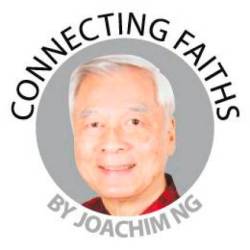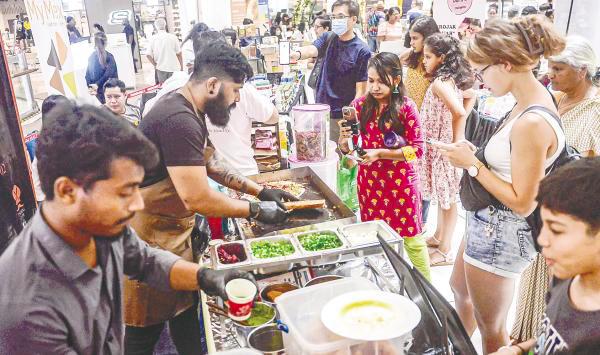WE have learnt that the classic Adam and Eve story in the old Hebrew scripture Torah is a masterful allegorical drama that subtly explains the fall of humanity into relationship conflicts in all spheres of life.
Tracing the path that humanity has taken, the story addresses the root malaise that leads to economic discord, ethnic conflicts, religious strife, national rivalry and now climate change.
Its essential message is conveyed by the centrepiece idiom da’at vav tov wa ra, which broadly means the “experiential knowing of serendipity and calamity” or good fortune and misfortune. If lightning strikes you while sheltering under a tree, it is calamity but not evil.
But we experience da’at vav tov wa ra as “good and evil” as a consequence of our mental bifurcation – division of human experiences into two combative halves. Ra becomes evil when there is a breach of harmony and a breaking up of what is good.
It is our mental bifurcation that creates evil by putting relationships into combative spheres of “I” versus “you” and “we” versus “them”. Instead of humanity in nature, life becomes humanity versus nature. We lose the sense of wholeness and the sense that all is one.
In falling out with nature and pursuing domination over it, humanity gets alienated from God, but it did not happen until recently. For some 300,000 years dating from the birth of humanity, small tribes of hunter-gatherer folks around the world lived in harmony with nature and God within nature.
As biologist John Parrington said in his book Consciousness (2024): “Hunter-gatherer society tends to be above all about cooperation, minimising conflict and ensuring that everyone’s role is respected.” Furthermore, “men and women enjoy equal decision-making powers”.
Parrington continued: “Given that egalitarianism, cooperation and reduction of conflict are key features of hunter-gatherer societies... it goes against claims that human beings are naturally drawn to inequality, competition, conflict and war.”
The falling away from unitive consciousness and from God began when humanity took the first step towards dominating nature. If we are to tag a specific year as a symbolic date to mark the fallout with nature – expulsion of Adam and Eve from the garden of Eden, so to speak – it will be 10,000 BCE. That is when the first crop planting communities arose, followed by the development of livestock herding 2,000 years later.
In the years that constituted a transitional stage preceding agriculture, tribes that were primed for this monumental step merged to form super-tribes.
Rather than continue their nomadic lifestyle, super-tribes built permanent settlements that could house hundreds of people, far more than the usual hunter-gatherer tribal population of around 150. With emergence of a ruling class and gender role differentiation, mental bifurcation started creeping into these complex societies.
The oldest example to date of such a pre-agricultural development is Gobekli Tepe in Turkey, built some 11,000 years ago. Gobekli was a settlement with stone buildings that were used for ceremonial gatherings of a super-tribe.
By 7,000 BCE, farming communities had sprung up in Catalhoyuk, Turkey. But agriculture was invented earlier. Hard evidence first surfaced when archaeologists unearthed a 10,000-year-old house near Jerusalem in 2013. Fossilised remains of domesticated animals and plants were found.
Farm and livestock ownership led to the creation of socially stratified societies with income and power inequalities, and an increasingly sedentary, urbanised and dense population.
While hunter-gatherer tribes were single indivisible units, agricultural societies were divided by labour specialisation into planters on one side and herders on the other side. This binary opposition, characterised by intense rivalry over land use and water resources, was the first great economic evil.
The Cain and Abel story in the Torah’s book of Genesis symbolises their violent conflict. Cain the planter murders Abel the herder, background details of which have been described in the first article of this series published on June 12.
Across a wide swath of Africa from coast to coast, drought has made violent confrontations more frequent in recent years as cattle herders push into farming territory in search of land and water.
A 2021 news article in The Guardian newspaper reported that violence linked to conflicts between farmers and herders has led to more than 15,000 deaths across west and central Africa.
Yet, the violence is preventable as it originates from bifurcation of the economy into the competing sectors of farmers and herders. The solution is to stop bifurcation through the forging of business relationships such as pooling of capital and joint ownership of land.
With more food available through crops and livestock, populations surged in numbers and towns were built to accommodate the bulge. Many towns grew into cities.
For instance, Jerusalem was just a town in 1800 BCE with a population of 700. By the time of Jesus, it had grown into a bustling city of 10,000 people – large by the standards of those days.
Urbanisation created a new form of mental bifurcation and the second great economic evil: in order for citizens to amass wealth, territories occupied by people of different ethnicities were seized through war and captives were turned into slaves to provide free labour that enabled the rise of civilisations across the entire globe.
All the religions that were anchors for civilisation in West Asia, Africa, Europe, America, India and China permitted the keeping of slaves as an economic necessity.
Although the abolishment of slavery began in 1863 with Abraham Lincoln’s Emancipation Proclamation, economic fragmentation continued in yet another form with the Industrial Revolution that introduced mechanisation.
Capitalism emerged to exploit labour, and to this day the owners of capital regard labour as a commodity that they want to procure cheaply. In Malaysia, the preference for lowly-paid workers from Bangladesh attests to this procurement bias. Across the food and beverage, plantation and building industries, you can hardly spot a local employee any more.
Despite the continually rising cost of living, JobStreet Malaysia Salary Guide 2023 showed no substantial change in median salaries across most sectors of the economy.
Even within the booming technology sector, the National Tech Association of Malaysia or Pikom reveals that average salary in Malaysia still falls behind the global industry average.
The latest report by United Nations Children’s Fund Malaysia released last month recommended that the minimum wage should be set at RM2,102, but a significant 35% of workers in the formal sector earn less than RM2,000 a month, according to figures released last year by the Department of Statistics Malaysia.
Across Europe, America and Canada industries are hiring cheap low-skilled immigrant labour for agriculture and hospitality, offering them poor pay and conditions.
As financier-philanthropist George Soros wrote in Capitalism Versus Open Society (2009): “There is a deep-seated conflict between capitalism and open society, market values and social values. The conflict has been successfully covered up by the market fundamentalist ideology.”
The bifurcation into capital versus labour worsens income inequality. This can be seen from the Gini Index, which determines a nation’s level of income inequality by measuring the income distribution or wealth distribution across its population. A Gini index of 0 represents perfect equality, while an index of 100 implies perfect inequality.
Malaysia’s Gini Index (2021 figure) is 40.7 and that is the same as the Philippines – not a great country to be on par with. Thailand does much better at 34.9. We are even behind Indonesia (38.3) and China (37.1) that were once far more impoverished compared to Malaysia.
A good way to dissolve the capital versus labour bifurcation is to require all companies, whether publicly listed or small and medium-sized enterprises (SME) with sales turnover from RM300,000 or with not less than five permanent fulltime employees, to make share allocations to all those who are citizens.
Loan financing should include a 10-year lock-in period during which the shares can only be sold if an employee resigns. Sell-back must be to the company only.
The law must also stipulate that at least 20% of the net income after taxes be distributed as dividends. If a sole proprietor of an SME earns RM300,000 net after taxes and has five citizen employees owning 20% of the company’s shares, these local workers get total dividend payout of RM12,000.
If they hold equal numbers of shares, they each get RM2,400 annual dividend on top of the standard bonus payment of one month. Commit them as part-owners to a high level of dedication and responsibility to the business.
Dissolution of the capital versus labour bifurcation will resolve the bumiputra equity shortfall. Economists currently use the wrong measure to determine their level of wealth.
At the latest Bumiputra Economic Congress in March, experts touted their measurement of the percentage of bumiputra share ownership in publicly listed companies as a gauge. This is a defective gauge as share purchase from the stock market is viewed as speculative, and many bumiputras avoid holding these shares as the up-down price swings affect their investments.
Measure the percentage of bumiputra share ownership across SME as well if our proposed solution of issuing shares to workers is adopted. This will result in the goal of 30% bumiputera equity ownership being instantly reached and surpassed.
The next article will analyse why our bifurcated mode of thinking damages ethnic relations around the world, including Malaysia despite 67 years of nation building.
The writer champions interfaith harmony.
Comments: letters@thesundaily.com










